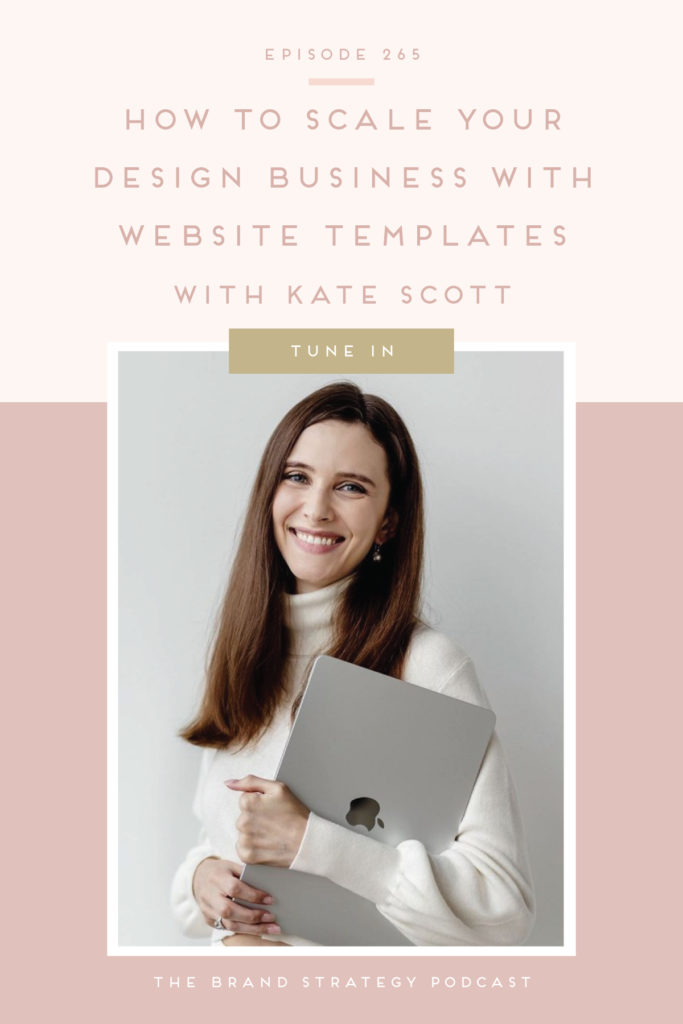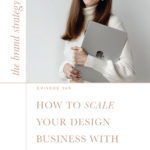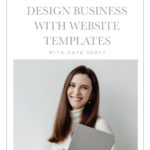Podcast: Play in new window | Download
Subscribe: Google Podcasts | Spotify | RSS

In today’s episode of the Brand Strategy Podcast, I’m chatting with Squarespace expert and online educator Kate Scott about how to scale your design business with website templates. Whether you’re a newer designer who’s curious about what it takes to create and sell your own website templates, or you’re an established designer who is looking to add to your existing services with website templates, Kate joins me to share her best tips on getting started with your own line of templates wherever you are in your business journey.
Meet Kate
Kate Scott is a strategic web designer and online educator empowering creative entrepreneurs and small business owners with the tools and education they need to build a compelling online presence. She specializes in the Squarespace platform and has helped thousands of people with her free tutorials, online courses, and website templates. Her clients and template customers have been featured in Forbes, Inc. Magazine, The Independent, and more.
CONNECT WITH KATE
SUPPORT THE SHOW
FOLLOW ALONG
LIKE THE SHOW?
IN ORDER TO PROVIDE CONTENT YOU LOVE I WANT TO HEAR FROM YOU! SUBSCRIBE TO THE BRAND STRATEGY PODCAST AND LEAVE A 5-STAR REVIEW HERE. THE MORE REVIEWS, THE MORE I’M ABLE TO PROVIDE THIS FREE-ACTIONABLE CONTENT!

Review the Transcript:
Please note the following transcript has been auto generated and may contain typos:
Bonnie (00:07):
Hi friend, and welcome to the Brand Strategy Podcast, a show created to equip you with the inspiration, encouragement, and clarity you need to build a brand of your dreams. I’m your host, Bonnie bti, brand designer, strategist, and founder of the Illume Retreat from sustainable strategy to heartfelt encouragement. Each episode is designed to equip you with the tools you need to chase after your dreams because you deserve a brand that empowers you to do what you love, connects with your dream clients, and offers a deep sense of fulfillment along the way. So grab a cup of coffee and join me on this journey, won’t you
Bonnie (00:45):
Friends, Welcome back to the Brand Strategy podcast where today we are talking about how to scale your design business with website templates with Kate Scott. If you haven’t met Kate before, I’m excited to be able to introduce you to her. She is a strategic Squarespace web designer and online educator, empowering creative entrepreneurs and small business owners with the tools and education they need to build a compelling online presence. Over the years, she’s helped thousands of people with her free tutorials, online courses and website templates. So she’s absolutely the person that we wanna be talking to about how we can scale our businesses as designers using website templates. So Kate, thanks so much for joining me. I’m really excited to get to chat with you today.
Kate (01:33):
Thanks for having me. Bonnie,
Bonnie (01:35):
If you’re up for sharing, I’d love to know a little bit more about yourself and this amazing business that you’ve built.
Kate (01:43):
Yeah, so I am a strategic web designer, as you said, and I specialize in creating high conversion Squarespace website templates, and also teaching other Squarespace website designers how to scale their businesses by building a successful template shop themselves. Um, and I’m really passionate about that scaling portion of my business because I think that so many web designers are just stuck on this hamster wheel of doing client work and feeling like their time isn’t their own and it’s really important for them to break free from that and feel like they are empowered to create their own schedule, create their own, um, income apart from clients.
Bonnie (02:26):
I couldn’t agree more. I think it’s so important for us as designers to be able to experience that freedom of reclaiming our time and our energy and things like templates or passive income can be such a powerful way to make that happen. Um, outta curiosity, how did you get started with website templates? Like how did you in your own journey kind of make that decision to start to pivot from working with clients to offering templates versus kind of that done for you service?
Kate (02:59):
So I actually made that transition pretty early on in my business. Um, I had transitioned, kind of pivoted my business from marketing to web design in May of 2019, and by the end of that year I was already working on building my first Squarespace template. And that really came about because I understood very quickly that client work wasn’t for me. I was both subconsciously and consciously kind of rejecting client work in favor of working on my own business and my own marketing strategy and kind of doing that internal work within my business because I really didn’t enjoy working with clients, um, the way that I, I thought I would. And so I started to build my first website template and I had absolutely no idea what I was doing. There were no online resources to help me. Um, it was a transition period within the Squarespace community where they were about to come out with Squarespace 7.1, which was a whole new platform. And so there were a lot of technical issues, there was a lot of figuring stuff out on the fly and it was a very chaotic process, . Um, and so, you know, after I went through that process, I finally launched my first website template almost a year after I had transitioned my business into web design. So it was a very rapid transition and then less than a year after that I actually quit client work altogether.
Bonnie (04:27):
Hmm. I really love that. To me, that speaks so much of this level of self-awareness that you possess, that you were able to tune in so quickly that client work. Hmm. Not really where my heart is and instead I think I could be doing so much more impactful work with website templates. And I think that, you know, there are probably people tuning in today who can relate to that kind of, that feeling of moving away from one-on-one client work, especially when in the design industry that is kind of the primary focus that a lot of coaches and educators, you know, point people towards.
Kate (05:01):
Well, and I also think that there’s a sense of you have to be successful at client work before you can scale your business. Mm-hmm. , and that’s just not true. Um, you can absolutely start a business by selling Squarespace website templates. You don’t have to start with client work at all if you don’t want to. And I think that, you know, some people want to scale because it provides more reliable income and that is a very like valid reason to do this. Um, but also some people just, it’s not a good fit for them ever. And you know, so I think understanding your reasons for wanting to scale your business are important, um, before you actually go through that process so that you can find the motivation to keep going, um, throughout the product creation process. Because I think there’s a lot of fear there when it comes to developing a website template. You know, when you’re working with a client, you get paid upfront or at least you get paid part of your fee upfront. But when you’re developing a product, you’re putting in all of this work and effort before you have anything to show for it. And so I think that you need a lot of internal motivation to get through that process when you don’t even know if it will be successful.
Bonnie (06:12):
That makes so much sense. And um, I think in my experience in the years that I’ve been a designer but also an educator for designers, where I see a lot of designers kind of getting stuck with that is they’re not really doing that first piece that you recommended, which is understanding kind of why they’re wanting to move towards templates. I think it, to some of us, it can look kind of like this quick easy amount of money that we can start generating and we underestimate the amount of time and energy that will actually take us to develop a template and then to create the marketing plan and actually launch it. Um, so out of curiosity, where do you recommend designers start that process with getting started designing and maybe launching their first website template?
Kate (07:02):
Well, I think first of all, if you already have a client base, then start with identifying what makes you passionate about certain projects over others. Is it a certain industry that you prefer working with? Is it a certain type of client? Identify those things what you’re passionate about and then build a template based off of that. You know, personally I’m very passionate about working with creative entrepreneurs. Those were always my favorite clients. And so I knew that I wanted to develop a template for those people. And also I had an existing audience base there as well. Now, not every designer is going to have like a really large audience to launch a template to right away. But thinking about what kind of audience you want to serve and what kind of audience you’re currently building is really important for your template to be successful. Because otherwise you’re gonna end up building something that no one in your community is going to want to buy cuz it’s just not the right fit. So I think it’s really important to do that foundational work of identifying your ideal customer and the the niche that you want to grow in before you actually start the process of designing your template.
Bonnie (08:10):
Mm. When you’re thinking about creating a website template for your specific niche, are there other aspects of kind of the, the support process that designers should be considering? You know, when I think about, um, designing a website template for someone who’s maybe not really confident in, you know, their ability to customize things in Squarespace, you know, I see a need for, you know, some tutorials or some resources or some kind of support. Um, I am curious, do you recommend that that’s something that designers are already thinking about at this kind of early stage? Or is that something that comes later?
Kate (08:55):
I think that’s a really important point to make. One of the things that I focus on when I teach about this is how to create an amazing customer support experience that not only leaves your customer feeling like they really got their money’s worth for your template, but also that takes the burden off of you when it comes to providing support. So one of the things that I teach and that I’m really passionate about is basically creating a little course that actually goes with your template and that shows cu uh, customers how to not only customize the template, the technical tutorials, et cetera, but also teaches them things about like branding and everything that they’re going to need to know in order to launch a really amazing website. So that’s ab absolutely a key part of this whole process
Bonnie (09:43):
That’s so smart because that then means that, um, you know, as the designer you are not answering the same question, you know, via email over and over and over again. Like, you basically have this resource that you can send to people when they reach out with those recurring questions. And it kind of takes that, that pressure off of you to be in this really time intensive kind of customer support role. Right?
Kate (10:10):
Yes. And it also allows you to kind of templatize certain answers to frequently asked questions. For example, if you find that a lot of customers are asking the same technical question and you’ve covered it in one of your course videos, which, you know, not everyone will always watch those course videos without you pointing them to them. You can create, you know, a templatized email that says, um, you know, hey, that’s at this point in this video, you can go into the course dashboard and watch that. And that’s something that takes two seconds to send to someone versus having to film a loom video for them, showing them how to do it each time. Um, so that’s, that’s definitely a key part of this. And it also allows you to kind of limit, um, your customer support to an extent. So one of the things that I also teach is setting boundaries around customer support. So typically when I deliver a client to a customer, it comes with 30 days of my free support, and after that point they can, they still have access to the course, they have access to Squarespace support, um, and they can also pay me for additional time. But that kind of puts a cap on how much time I need to invest in customer support and it keeps it very manageable, even if I have a lot of customers.
Bonnie (11:25):
Mm, absolutely. So you’re not dealing with people who are like coming out of the woodwork like a year later with all these really specific questions. You have this process already created where you can point them back towards those resources that you’ve created or they have the option of hiring you and getting more personalized support.
Kate (11:44):
Exactly. Because without that system in place, let’s be honest, a year down the road, if you’re successful, you’re gonna spend all of your time answering support emails. And that’s basically just like doing client work again, , which we’re trying to avoid
Bonnie (11:57):
. That is such a good point. So, you know, these are some really fantastic practices that can serve designers well as they start this journey. But I am curious if there are any, since you know, I know this is this, you know, area of expertise and you teach on this, are there any like mistakes or, um, actions that you see designers making as they get started with offering templates that you would really love to see folks, um, maybe not make in the future?
Kate (12:30):
I think honestly the biggest mistake, and it, it kind of feels like beating a dead horse to an extent to say this again, but it’s not getting started to begin with. I recently did a poll in my private Facebook group asking my group members basically, where are you in the design process right now? And as I expected, the majority of them haven’t gotten started. And so I asked a follow up question, what is stopping you from getting started? And the number one response was, I’m overwhelmed with client work. Mm. And I think that this comes back to, um, asking the core questions about why you are doing this to begin with. If you don’t treat yourself like a v I P client, you’re never gonna be able to build the foundations to have semi passive income in your business. To have a successful template shop, you have to actually do the work before you can have that. And I think that, you know, again, that fear of, well, what if I’m not successful really gets in the way of people getting started and so they never reach the finish line because they never crossed the starting line to begin with. So that’s the number one thing, um, that I see that, that people make the mistake of is they know they want this, but they’re afraid to get started basically.
Bonnie (13:46):
Hmm. That’s really interesting. I I’ve seen that in a lot of areas of, of business with clients in the past, and I think that for some folks it’s equal parts, this fear of failing. Like if they, if they launch and no one buys, like how disappointing that’ll be. But sometimes I also think that some people are afraid of, what if I’m more successful than I can handle? What if I get more orders and my workflows break and I can’t handle all the customer support questions and you know, I have to do all this stuff. But that kind of core fear, I think is, is the same in both of those scenarios. It’s this fear of the unknown. It’s this new thing that we’re doing and we’ve never done it before. And so we don’t really know what it’s gonna look like in our businesses or what it’s gonna feel like, but I think there’s a reason why people are feeling attracted to offering templates and maybe phasing out client work. And it’s important to revisit those, those goals, those dreams, that kind of feeling that initially attracted you to this. And in a lot of cases, I think we can, you know, once we ground ourself in that knowledge and in that truth, we can find that our attraction, our desire, our excitement about this is, is greater than the fear of the unknown. But in your experience with your students, um, is that something that kind of resonates?
Kate (15:17):
Yeah, absolutely. And, and you know, I think the key is to remember also that in addition to, you know, remembering why you wanted to do this in the first place, understand that whatever obstacles may come up in your path, they are manageable. If you’re successful beyond your wildest dreams, you can hire a team to support you. And that’s something that I actually recently started doing. I hired a senior designer to help me kind of develop my new line of templates. Um, you know, if you’re struggling with making sales after you launch your template, you can identify the reasons why that might be happening and improve your marketing strategy, make it more efficient, um, make it more sustainable. You can, you know, you can get help there to identify the bottlenecks that are stopping you from getting to where you want to be. There’s always a solution to those problems, but there is never a solution to not doing anything. Like if you don’t do anything, you’re never gonna get there. That’s the end of it. So there’s a, but for everything else there is a solution.
Bonnie (16:17):
Hmm. I love that. That’s that kind of that, you know, feeling of knowing that you can trust yourself, that you can figure this out and that, you know, if you’re moving forward with that attitude, you’re not going to be struggling with something that feels like it’s impossible to figure out for long. Um, when you are chatting with designers who are curious about offering website templates, are there any like resources or recommendations that you would like to share?
Kate (16:53):
Absolutely. So I actually have a free training on my website, um, that basically goes over some of the, um, biggest mistakes I think that people make at every step of the process of designing and creating an offer for your template and all of those things. Um, so that you can find that at kate scott.co/training. Um, and that just kind of gives you a place to get started. It’s not the whole picture, but it’s uh, kind of a guide for how to avoid some of those bottlenecks and roadblocks that you might encounter.
Bonnie (17:25):
That’s amazing. Thanks so much for sharing that. Um, one question that I always like to ask during every conversation here on the podcast is kind of a final piece of advice or encouragement that you would like to share for those who’ve been tuning in today who are really ready to start to take that action to scale their design businesses using website templates.
Kate (17:49):
I think the biggest thing I would say is to be patient both with the process of creating semi passive income in your business and with yourself. You know, the, the process for me of when I started designing my first template to when I was able to quit client work took a little over a year. And honestly, the only reason it happened that quickly is because I had already put in place a very strong marketing system, a sustainable marketing system, um, and my first template was really successful and part of that was, you know, good audience research and part of that was just luck. My second template did not do as well as my first template incidentally. So I think that, you know, for some people their first template may bomb and it may take doing another template to really find, um, that place where people resonate with your work. And so be patient with the process. It’s not gonna happen overnight, but there is a path forward. If you can kind of figure out what your audience wants and how you can offer that in a way that brings you joy, you will find a way to make this a sustainable form of income in your business.
Bonnie (18:57):
Mm-hmm. , that is such great advice. Out of curiosity, for those who want to continue learning from you and, um, you know, follow along with what you’re doing, where can they find you online?
Kate (19:12):
You can find me on my website, kate scott.co. And you can also find me on Instagram at kate scott co.
Bonnie (19:19):
Amazing and friends who are tuning in today. As always, all of Kate’s info, the link to her free training and the links to where you can connect with her online will be in today’s show notes. You can go to brand strategy podcast.com, click on the latest episode link and you’re gonna find everything you’re looking for there. Kate, thank you again for just sharing your time, sharing your expertise, and making this journey into website templates as a way to scale seem a lot less complicated than it might have at the start.
Kate (19:56):
Thank you so much for having me, Bonnie. This is something that I’m really passionate about and I hope that some designers who are listening will, um, find inspiration in it and hopefully scale their own businesses.
Bonnie (20:07):
I’m confident that this is gonna plant some seeds for quite a few folks who are tuning in. So, um, friends who’ve been listening, if this resonates with you, I encourage you to check out Kate’s free training so that you can really explore what these next steps will look like. If you have an industry friend who is thinking about maybe phasing out client work or maybe doesn’t even wanna engage with client work at all, they wanna just go straight to designing website templates, definitely share this episode with them. Um, our goal here is just to help more designers learn how to build a business that lights them up and that serves them well. And so with all that
Bonnie (20:46):
Being said, thanks as always for tuning in and I’m cheering y’all on from Waco.
Bonnie (20:54):
Thank you so much for joining me today. Friend. Before you go, I would be so grateful to receive your feedback on the brand strategy podcast. If you enjoyed this episode or the podcast in general has helped you grow your brand, I’d really appreciate it if you left us a review in iTunes. Your positive reviews enable the brand strategy podcast to continue to grow and reach like-minded creatives just like you. Thank you for all your support and encouragement as together we pursue building brands with purpose and intention. Until next time, end cheering you on from Waco.









leave a comment